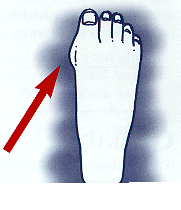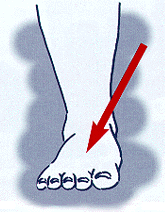See how DownUnders insoles can help with:
Knee Pain
 Aliment:
Aliment:
A sharp pain in the knee during activities like walking up-stairs or getting out of the car. In addition, a dull ache around the knee cap may occur after sporting activities or getting out of a chair. Also, the person may experience a crunching/clicking sensation around the patella.
Biomechanical Involvement:
Internal tibial rotation, associated with excessive pronation, medially displaces the patella-femoral path and encourages lateral displacement of the patella. This is a common problem and elicits pain under and about the patella, especially with excess loading activities such as running.
Remedy:
Common treatments involve the reduction of pain and balancing of soft tissue structures. However, knee pain commonly associated with excess pronation responds well to foot orthotics. DownUnders Footbeds™ effectively provides the foot with a natural foot cradle which provides a stabilizing angle or centering for the calcaneus (heel) with its custom molding heel cup. The custom heel cup reduces the calcaneal eversion (heel roll-in) associated with excess Subtalar Joint (mid-foot) pronation and reduces secondary internal tibial (leg) rotation.
Shin Splints
 Aliment:
Aliment:
Tightness and pain along the medial posterior border of the tibia(s) that comes on with a specific activity (especially running of long distances) and often settles upon resting.
Biomechanical Involvement:
Excessive Subtalar Joint pronation and internal tibial rotation increases the medial tractional forces upon the deep flexors of the leg. This is a common factor in muscular overuse conditions and is commonly found with secondary periosteal swelling due to tractional forces placed upon the soft tissue structures on the tibia.
Remedy:
By preventing excess Subtalar Joint pronation, DownUnders Footbeds™ assists reduction of internal tibial rotation and reduces medial tractional forces upon the tibia. This provides an effective solution to shin pain.
Lower Back and Hip Pain
 Ailment:
Ailment:
Dull ache and stiffness in the lower back (lumbar) region or pain in the right or left hip, especially after standing for long periods.
Biomechanical Involvement:
A singularity or Bilateral excess Subtalar Joint pronation internally rotates the tibial & femoral shafts which can lead to a forward shift of the center of gravity, loading the forefoot and resulting in a secondary lordotic (low back curvature) tilt and muscular tightness. Unilateral excess Subtalar Joint pronation lowers the vertical distance of the foot to the ground, causing hips mal-alignment. Excess Subtalar Joint pronation involving one foot only promotes hip drop as the opposite hip will hike due to one foot being pronated and the other being neutral or supinated.
Remedy:
DownUnders Footbeds™ assists to align the body's posture by reducing the foot's excess pronation or supination. This neutral positioning is created by the custom self-molding of the heel and arch chassis. By aligning the feet, the legs de-rotate and the hips are balanced improving the biomechanical etiology of the lower back and hip pain. As it is said "the hip bone is connected to the leg bone . . . .etc."
Plantar Fascitis (Heel Spurs)
 Ailment:
Ailment:
A dull to sharp pain occurring about the plantar calcaneal area, about the mid arch area, and rarely the forward area of the arch when arising from the resting position and begin to walk, especially during the initial periods of weight bearing. This sometimes subsides within a few minutes and may re-occur once this sequence is re-established. However, the pain is more likely to increase its intensity the with continued periods of weight bearing and foot activity like standing, walking, and especially running.
Biomechanical Involvement:
Excess Subtalar Joint pronation lowers the arch structure, elongates the foot and places a tractional force on the plantar fascia. The continual traction of the plantar fascia at the calcaneal (heel attachment) tuberosity commonly leads to the development of a bony growth at the plantar fascia's calcaneal attachment forming - a heel spur.
Remedy:
Biomechanical Plantar Fasciitis is best treated mechanically by neutralizing the foot structures. DownUnders Footbeds™ control excess Subtalar Joint pronation through its "Active Arch" which forms to each individual's arch shape and height. Therefore, the device will assist the arch in rising in supination, and plantar fascia tension will be released while simultaneously reducing ground reaction forces under the heel and allows accommodation for any inflammatory or bony process.
Achilles Tendonitis
 Aliment:
Aliment:
The patient presents with a sharp or sometimes hot, 'nagging' pain above the heel.
Biomechanical Involvement:
The calf muscles assist inversion of the calcaneus at heel lift. When the foot accelerates into an excessively pronated position and the calcaneus is everted, there's an increase in medial tendo-achilles traction and this results in transverse shearing of the tendon and sheath - this commonly leads to inflammation and pain.
(This mechanism has been linked to Sever's Disease, restless leg syndrome and 'growing pains' etc.)
Remedy:
By preventing excess Subtalar Joint pronation DownUnders Footbeds™ release medial tendo-achilles traction, therefore helping to alleviate the problem. Calf stretches and/or myofacial release is also very effective in conjunction with the use of orthotics.
Bunions
 Ailment:
Ailment:
Biomechanical Etiology:
Due to excessive pronation, forces load the medial forefoot area. This increases the load on the 1st metatarsal in an adductory direction, causing rotation of the shaft, which then requires the Hallux (big toe) to compensate by abducting. Feet that have short 1st metatarsals, adducted 1st metatarsal shafts or are hypermobile are more susceptible to this condition.
Treatment:
DownUnders Footbeds™ control excessive pronation, thus reducing load on the medial forefoot area and reducing valgus deviation of the hallux.
Metatarsalgia (Forefoot Pain)
 Ailment:
Ailment:
Biomechanical Involvement:
When a foot is pronated excessively for any length of time, there is a progressive weakening of the soft tissue structures, resulting in ligamentous laxity and muscular wastage. In the forefoot, as this occurs the metatarsals plantarflex and rotate, losing their transverse arch. This results in shearing forces on these foot structures, which cause pressure and pain. After a period of time the foot may experience nerve damage or callosities.
Remedy:
DownUnders Footbeds™ re-align the metatarsal heads by dorsiflexing the 2nd, 3rd & 4th metatarsals to their neutral position and controlling excess pronation which prevents plantarflexion and shearing of the metatarsal shafts.
Neuroma (The Other Forefoot Pain)
 Ailment:
Ailment:
Biomechanical Involvement:
When a foot is pronated excessively for any length of time, there is a progressive weakening of the soft tissue structures, resulting in ligamentous laxity and muscular wastage. In the forefoot, as this occurs the metatarsals plantarflex and rotate, losing their transverse arch. This results in shearing forces on these foot structures, which cause pressure and pain. After a period of time the foot may experience nerve damage or callosities.
Remedy:
DownUnders Footbeds™ re-align the metatarsal heads by dorsiflexing the 2nd, 3rd & 4th metatarsals to their neutral position and controlling excess pronation which prevents plantarflexion and shearing of the metatarsal shafts.
